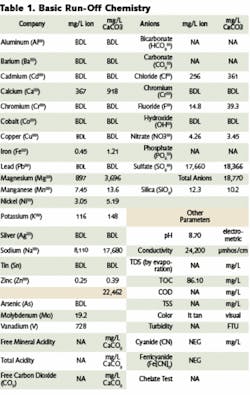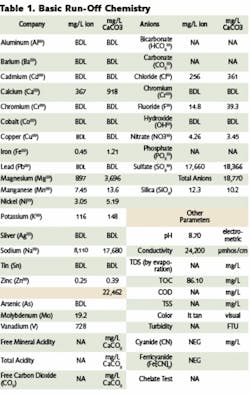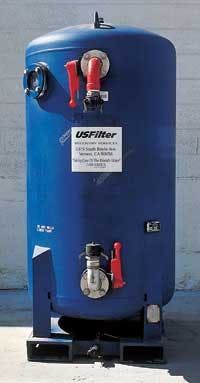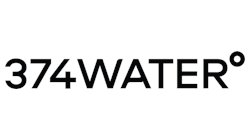As the U.S. population grows, so too does demand for energy. This demand has fueled a steady increase in coal production, as coal-fired power plants are one of the most inexpensive ways to produce electricity in the United States. Since 1978, U.S. coal production has increased from 417 million tons to 1,082 million tons in 2002. This increase is expected to continue for the foreseeable future.
After coal is burned at the plant, the residual ash is removed from the boiler and sent to a holding area. The ash can contain metals like arsenic, vanadium or mercury, so it must pass a TCLP (Toxicity Characteristic Leaching Procedure) test to determine if the amount of metals leaching from the pile pose a threat to the surrounding water table. This test measures the amount of metals that would leach from a material if it were exposed to acid rain. If the ash passes the test, it can be used as a fill material for mine reclamation or some other purpose.
As these piles accumulate at a plant, the runoff is typically collected and tested for metals prior to discharge. As testing methods improve and more is learned about harmful effects of some metals, discharge standards are reduced. When the retention pond contains metals exceeding discharge standards, the runoff must be treated or hauled off site for disposal.
Assessing Options
When a coal-fired power plant in the Northeast discovered that the runoff from its ash pile contained vanadium levels exceeding discharge limits, it contacted a water treatment vendor for assistance.
The plant’s small retention pond contained roughly 400,000 gallons of water with 30 ppm of vanadium. Operators asked the water treatment vendor for a temporary solution that would remove the vanadium to less than 4 ppm. Based on results of a water analysis performed by the vendor (see Table 1), several technologies were considered. Trailer-mounted reverse osmosis (RO), chemical treatment, ion exchange or simply hauling the water offsite for treatment were evaluated as possible solutions.
Reverse Osmosis
According to a computer model supplied by an RO membrane manufacturer, this process could remove the vanadium. As the installation site had no existing structures to protect the RO from the elements, a trailer-mounted RO system seemed to be the best solution. It could be delivered quickly and would be completely enclosed. Plant personnel ruled out the RO system, however, because of the additional waste streams it would produce (i.e., concentrated permeate) and manpower required to support the unit.
Ion Exchange
Test results showed ion exchange (IX) resin would remove roughly two pounds of metal for every cubic foot of resin. Calculations indicated the entire pond could be treated with less than 60 cubic feet of media.
It was decided the final design would incorporate a 60-gpm, self-priming pump with a floating intake to minimize the amount of solids taken up from the bottom of the pond. To extend run time between resin change outs and reduce pressure loss, coarse filtration was added after the pump to protect the ion exchange columns from suspended solids.
Setup
Two 36” x 72” steel vessels, each containing roughly 30 cubic feet of resin, were brought to the site. The two tanks were installed in series with sampling ports after each vessel. The final effluent is sent to a holding tank for testing by a state-certified laboratory prior to discharge, to confirm that the vanadium level is within limits.
The water treatment vendor provided technicians to install the system and sample water on a set schedule. Samples were taken between the two ion exchange tanks and after the final unit. The plan was to test the water between the IX vessels every hour until the results showed vanadium levels above 4 ppm or 50% of the incoming level. At that point the first vessel would be removed and a fresh unit installed at the end of the train. The unit in the second position would then become the primary unit. This process would continue until the entire 400,000 gallons was treated. By installing two units in series, the vendor was able to maximize use of the ion exchange columns. A single column would need to be changed before the effluent reached 4 ppm, leaving a good portion of the resin bed with remaining capacity. The two-bed design improved the economics of the system and ensured the vanadium level in the final effluent never climbed near the discharge limit.
Results
The original sample tested in the vendor’s Roseville, Minn., lab only showed the quality of the water at the surface of the pond.
Concern arose over the fact that as the bottom of the pond approached the pump suction, the water profile may change and something may emerge to reduce the loading potential of the resin. Additional ion exchange tanks were staged at the vendor’s local service office to reduce downtime if additional capacity became necessary.
The ion exchange vessels were steel tanks with 2-inch quick-disconnect fittings. This allowed for a simple installation using fire hoses. The tanks were taken off the truck with a fork lift and set on the ground near the pond. When the job was completed, the tanks were shipped to the vendor’s fully permitted, centralized treatment facility. This RCRA Part B facility in Roseville can accept and process a wide range of inorganic wastes. In this case, the resin was recycled and the metals properly disposed of as required.
Conclusion
The customer’s problem was solved quickly and economically. The estimated final cost of the project was approximately $50,000 less expensive than the original plan to haul the water offsite. The vendor provided a totally service-based solution, allowing power plant personnel to focus their resources on the core business, without any capital expenditure. Moreover, the plant wasn’t left with equipment that may or may not be needed in the future. IWW
About the Author: Jeff McCormick, the wastewater ion exchange product manager for USFilter, has been with the company for 12 years. He has 19 years of experience in the water treatment industry and holds a bachelor’s degree in chemical engineering from Grove City College in Grove City, Pa. Contact: 724-772-1437 or [email protected].




